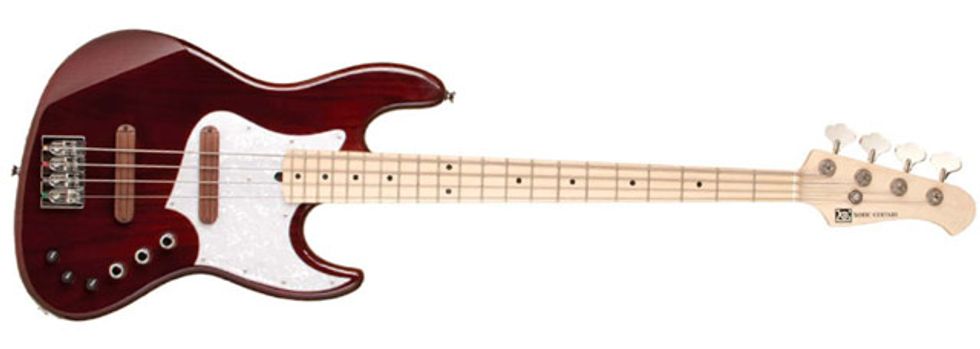| Download Example 1 Active - Bridge | |
| Download Example 2 Passive - Neck | |
| Download Example 3 Active - Both | |
| Download Example 4 Active - Humbucking |
Flair for the Xotic
The XJ-1T is more than just a classic Jazz-style bass. Even though the body is inspired by a timeless classic, the bass is pure Xotic. There are some traditional features that players would expect, like a bolt-on 22-fret neck, offset body and all the appearance of a high-end J-bass clone. Features that distinguish the XJ-1T from other offerings on the market are the eye-catching Lindy Fralin pickups, Hipshot UltraLight tuners and bridge, a custom-shaped pickguard and the secret weapon of any Xotic: the electronics. Xotic has always been known for their pedals and preamps, and bassists can revel in the fact that their popular 3-band preamp is onboard the XJ-1T. The system runs at 18 volts for extended headroom and is a tone tweaker’s delight. The chrome knobs are the same as a traditional J-bass: an individual volume control for each pickup and a master tone. The mini-knobs are for the active preamp and control bass, mid and treble.
This is not all that dwells deep within the XJ-1T. Both of the volume knobs on the bass are push/pull. The first allows the bass to go into passive mode for going completely classic J sonically. The second is a unique humbucking mode that combines both pickups as one big pickup. In this mode, your front volume control now becomes a master volume for some serious thunder. For the tweaking obsessed, we’re still not over with the Xotic. Accessible through the back panel are additional mid-frequency switches and even an output gain control. You can literally spend hours dialing in the bass to whatever you fancy. Granted, the stock settings are top notch, but this is a super-cool option nonetheless.
Feature-wise, the bass is very similar to the 2009 Xotic XJ-1T 5-String—the most obvious difference being the fact that it’s got one less string. But due to its wood combination, the XJ-1T 4-String has the heart of a ‘70s J-bass. It sports an oil-finished maple neck with a maple fretboard, unlike its 5-string cousin. Both basses do use 6150 Jescar nickel-silver frets. The other difference is the ash body on the XJ-1T. The instrument just has the feel of a ‘70s gem… without the disco music and large collars.
Just taking it out of the case, I was seriously impressed with the overall craftsmanship, and after hours of inspection I was honestly quite surprised not to find any real flaws. The stock setup was nice and even, but due to my lighter playing style, I dropped the action. Luckily, the bass didn’t need any other tweaks and it was set up like an absolute dream. The oil-finished neck has a wonderful worn-in feel. Most surprising was how resonant the bass was even unplugged. Sustain and articulation was off the charts, and there was just the right amount of midrange bark, which was surprising since maple and ash combinations have the potential to be overly bright sounding. To test the bass, I used it on a number of live dates as well as master and demo sessions. In every aspect the bass delivered completely. You can really tell that Xotic has done some serious homework on this bass, and I’d venture to guess they’ve been asking players for their needs as well. Every tone setting proved to be useful for a number of needs. Slap players can get a very Marcus Miller-like tone from the active electronics, and the Fralins are seriously clean and easy to record. What I particularly dug was the fact that I could also dial in a good Jacoesque tone out of the soloed bridge pickup. J-basses can usually cover one or the other well, but not both.
The Final Mojo
Is it worth the funds for this bass in comparison to other, US-built J clones? Absolutely. It sounds as good, if not better than, any other contender out there. Even more important is that it’s more flexible than most. This bass is a Swiss Army knife and could be considered a main axe regardless of what genre you’re in. I myself am already enjoying being able to leave a number of other basses in my studio and just taking the XJ-1T to sessions. If you’re a lover of high-end J-basses, this may very well be your axe.
Buy if...
you’re into great-sounding, high-end J-basses.
Skip if...
you’re not ready to drop more than $2K on an import.
Rating...
MSRP $2700 - Xotic - xotic.us |







![Rig Rundown: AFI [2025]](https://www.premierguitar.com/media-library/youtube.jpg?id=62064741&width=1245&height=700&quality=70&coordinates=0%2C0%2C0%2C0)












 Shop Scott's Rig
Shop Scott's Rig


![Rig Rundown: Russian Circles’ Mike Sullivan [2025]](https://www.premierguitar.com/media-library/youtube.jpg?id=62303631&width=1245&height=700&quality=70&coordinates=0%2C0%2C0%2C0)












































